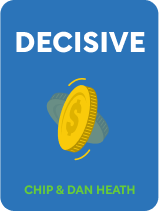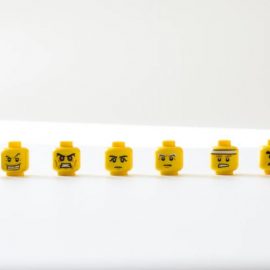

This article is an excerpt from the Shortform book guide to "Decisive" by Chip and Dan Heath. Shortform has the world's best summaries and analyses of books you should be reading.
Like this article? Sign up for a free trial here.
What is the WRAP framework? What are the four steps in Chip and Dan Heath’s WRAP decision-making process?
In their book Decisive, Chip and Dan Heath organize the four steps of their decision-making process into a mnemonic called “WRAP.” Each letter in the acronym stands for a step in their process: Widen Your Options, Reality-Test Your Assumptions, Attain Distance Before Deciding, and Prepare to be Wrong.
Let’s examine the four steps of the WRAP decision-making process, including specific strategies for implementing each step.
Step 1: Widen Your Options
Because of binary thinking, during the first step of the WRAP decision-making, we tend to come up with only two options. The Heath brothers argue that we can improve our decisions by coming up with more options. They cite research that suggests considering more than two distinct options facilitates faster, more creative decisions that better suit our needs. Additionally, doing so guarantees that you have at least two backup options. However, the authors warn that having too many options overwhelms you. They suggest that you aim for three to four strong, distinct options.
Strategy 1: Both/And Thinking
Binary choices are between choice A or B, but it’s often better to pursue a both/and option: one that combines the best parts of both A and B. One technique for creating a both/and option is to combine an optimistic choice with a cautious one. According to the authors, a cautiously optimistic option prepares you for a range of outcomes—both positive and negative. It serves as a middle ground between a high-risk option and one that’s too prudent.
For example, imagine a postal worker who’s considering quitting his job to become an artist. Within the binary of “quit or not,” the optimistic option is to quit and hope he can earn a living making art. The cautious option is to continue as a postal worker. A cautiously optimistic option could be to reduce his hours at the post office while he takes time to launch his career as an artist.
Strategy 2: Imagine Eliminating Options
Another strategy for developing more options is somewhat counterintuitive: Imagine that one or more of your options have been eliminated. The authors claim that when we rule out an option, we handle this constraint by creatively developing other options.
For example, consider someone who wants to sign up to run a full marathon. However, they’re new to running, and they wonder if they’ll be ready in time. After they imagine eliminating the option of running a full marathon, they research other possibilities. They add “run a half-marathon” to their list. It’s an option that’s both ambitious and realistic.
Strategy 3: Learn From Experts
A final way to develop additional options is to learn from experts. The Heaths define an “expert” as anyone who has more experience than you with the topic of your decision. Experts may be able to share tried-and-tested options that you hadn’t even thought of.
For example, consider a teenager who asks his parents for a cell phone. His parents want to please him, but they’re reluctant to increase his social media access. To produce an extra option beyond the binary of “phone or no phone,” they could seek advice from other parents who’ve bought their children cell phones about how to supervise and limit children’s social media use.
Step 2: Reality-Test Your Assumptions
After you develop two to four appealing options, it’s time to evaluate them. However, because of confirmation bias, we often ignore crucial information about our options. The Heaths emphasize that while we can’t eliminate our confirmation bias, we can resist its power and make well-informed decisions. In this section, we’ll share several strategies for doing so.
Strategy 1: Seek Out an Opposing Viewpoint
One way to resist your confirmation bias is to hunt for information that contradicts your existing beliefs. The authors claim that according to research, when we consider an opposing viewpoint, we force ourselves to pay attention to high-quality information that we’d otherwise ignore due to confirmation bias.
A technique to accomplish this strategy is to find an expert on the topic of your decision and ask questions that welcome an opposing viewpoint. For example, imagine a high school graduate who must choose among several colleges. One college tops their list because they believe it has a strong art program. They meet with an admissions counselor from that college to learn more. Their confirmation bias tempts them to ask questions that confirm their belief that the art program is strong. Instead, they can seek out an opposing viewpoint by asking, “What are some issues with the art program?”
Strategy 2: Seek Out Objective Information
The authors argue that due to our confirmation bias, we trust our biased instincts over more accurate data about what people in a similar situation have experienced. To overcome this, we can seek out objective information.
One way to do this is to pay attention to base rates: statistics that describe the percentage of a population for which something is true. For example, the aforementioned college applicant could compare base rates from each college that show what percentage of its art majors find a job in the arts after graduation.
The authors offer another way to seek objective information: Ask an expert questions that prompt them to share factual information, specifically. The authors recommend that you avoid asking questions about the future. For example, the college applicant shouldn’t ask the counselor, “Do you think this program will prepare me for an art career?” This question may fall prey to the counselor’s own biases. Instead, the authors instruct us to ask questions about the past and the present. An expert provides a more objective perspective on these types of questions.
- A present-focused question: “What are ways you provide current students with job experience?”
- A past-oriented question: “What are some arts-based careers that recent graduates have found?”
Strategy 3: Conduct a Trial Run
A final way to consider objective information is to generate it yourself. As previously stated, our confirmation bias prevents us from making credible predictions by distorting how we interpret information. To further overcome this bias, the authors suggest gathering more credible information by conducting a trial run of at least one option. A trial run is a test that allows you to accurately evaluate an option, since it provides evidence of the option’s outcomes. This evidence helps you make an informed prediction about how the decision may pan out long-term.
For example, a man who’s unsure whether he wants to move in with his partner could conduct a trial run by moving in with them for two weeks. This experience and its pros and cons could inform whether or not he stays beyond that time.
Step 3: Attain Distance Before Deciding
As previously noted, tough decisions heighten our emotions, which compels us to avoid change. Our bias towards the status quo tempts us to choose whichever option minimizes loss and change—even if change is what we most need.
To overcome status quo bias, the authors argue that we shouldn’t disregard the current emotions that drive us to seek comfort in the status quo. Instead, we should put those emotions into perspective by looking outside ourselves and beyond the present. In this section, we’ll share several strategies for doing so.
Strategy 1: Imagine What Someone Else Would Do
One strategy for putting your current emotions into perspective is to imagine the point of view of someone else who’s not experiencing the same strong emotions. The authors claim that this strategy allows you to more rationally and objectively see the decision’s important facets. You might then recognize the value of disrupting the status quo and seeking beneficial change. For any kind of decision, ask yourself, “If my friend or colleague was in this situation, what decision would they make, and why?”
Strategy 2: Look Far Into the Future
A second way to put your emotions into perspective is to predict how you’ll feel about your decision at various points in the future. The authors state that we make better decisions when we give additional weight to our future feelings. When we consider how we’ll feel in the future, we’re more likely to welcome a change in the status quo.
One technique the authors recommend is the “10/10/10 test,” created by business writer Suzy Welch. First, select one of your options. Then, ask yourself, “If I chose this option, how would I feel about my decision 10 minutes, 10 months, and 10 years after I made it?” If you determine that you’d feel positively about that option at all three points in the future, it’s a strong option.
Strategy 3: Clarify Your Values
In some cases, it may not help to imagine someone else’s perspective or look far into the future. Even after trying these strategies, the decision may continue to be emotionally fraught. The authors share that when a decision is still emotionally fraught, it’s a sign that it may be a choice between one or more of your values. They claim that the best way to work through a decision that concerns multiple values is to clarify which of those values are most important to you.
One value-clarifying technique that the authors recommend is a “stop doing list.” Business consultant Jim Collins created this technique.
- First, imagine receiving two phone calls: one telling you that you’ve been given 20 million dollars, and another sharing that you’ll die in 10 years.
- Next, ask yourself: What do you want to spend more time doing to make those last 10 years meaningful? What do you need to stop doing to make that possible?
- Finally, the Heath brothers add another step: Look at your schedule and remove everything you decided you want to stop doing. What you leave behind reflects what you value most, and what you cut reflects what you don’t value as much.
Step 4: Prepare to Be Wrong
After you’ve made a choice, the decision-making process isn’t necessarily over. The authors claim that after you make a decision, you can take action to increase the odds that your decision will succeed.
As previously stated, our hubris makes us overconfident in our predictions for the future, which causes us to poorly prepare for the decision’s outcomes. The authors argue that we can overcome our hubris with humility, and increase the likelihood that our decision will succeed, by:
- accepting that we can’t predict the future
- instead, preparing for a range of possible outcomes
Strategy 1: Make Contingency Plans
The authors share that one way to plan with humility is to prepare for both best-case and worst-case scenarios. By planning for both types of scenarios, we ensure that the worst-case scenario won’t be devastating and that we’ll be more prepared for the success of the best-case scenario.
For example, consider a woman who decides to quit her job and open a food truck. First, she imagines a worst-case scenario and makes a plan for it.
- Worst-case scenario: An accident totals her food truck.
- Plan: She guards against this outcome by purchasing insurance.
Next, she imagines a best-case scenario and makes a plan to be ready for it.
- Best-case scenario: A food critic’s rave review doubles her number of customers.
- Plan: She contacts several friends who work in food service. She tells them that if her demand starts to double, she’ll offer them a job to join her in the kitchen.
Strategy 2: Prepare for the Unexpected
When it’s challenging to accurately predict a decision’s worst-case outcomes, we can still prepare for the unforeseeable. The authors argue that even though our hubris will cause us to underestimate the worst-case scenario, we can negate that hubris by working “safety factors” into our predictive calculations. A safety factor is a cushion we can add to our prediction of the worst-case scenario. If it turns out that the worst-case scenario was too optimistic, then the safety factor helps us avoid disaster.
For instance, imagine that the food truck owner estimates her business expenses. She multiplies those estimated expenses by a safety factor of 1.5. That way, if it turns out her estimate fails to account for unexpected costs, she avoids draining her bank account.
Strategy 3: Create an Alert
A final step we can take to prepare for future outcomes is to ensure that we act early if we notice any signs that our decision is headed towards a negative outcome. Our hubris may tempt us to ignore these signs, so the authors recommend that we humbly assume our decision will have negative outcomes. They advise us to proactively create an alert: a reminder for us to act that fires in response to early signs of a negative outcome. Alerts ensure that we recognize when it’s time to follow up our decision with another decision that steers us off the path toward a negative outcome.
One type of alert that the authors offer is a deadline. After you make a decision, choose a date in the near future. When that date arrives, evaluate the success of your decision so far and determine whether you need to change course.
Another type of alert that the authors offer is a pattern. After you make a decision, list several possible warning signs that the decision is headed towards a negative outcome. If you notice a pattern of more than one warning sign, it’s a signal that you need to either re-evaluate your decision or follow it up with another one.
For example, imagine a teacher in a classroom that has several students who are new to the school. He wants to ensure that they’re integrating well with their peers, and he determines that sitting alone at lunch would be a sign of poor integration. Each day, he observes the students eating. If he ever notices that a student sits alone more than two times, this pattern alerts him to decide how to better support them.

———End of Preview———
Like what you just read? Read the rest of the world's best book summary and analysis of Chip and Dan Heath's "Decisive" at Shortform.
Here's what you'll find in our full Decisive summary:
- Why our minds are wired to make bad decisions
- How biases and cognitive flaws distort your thinking
- A four-step process to improve your decision-making






